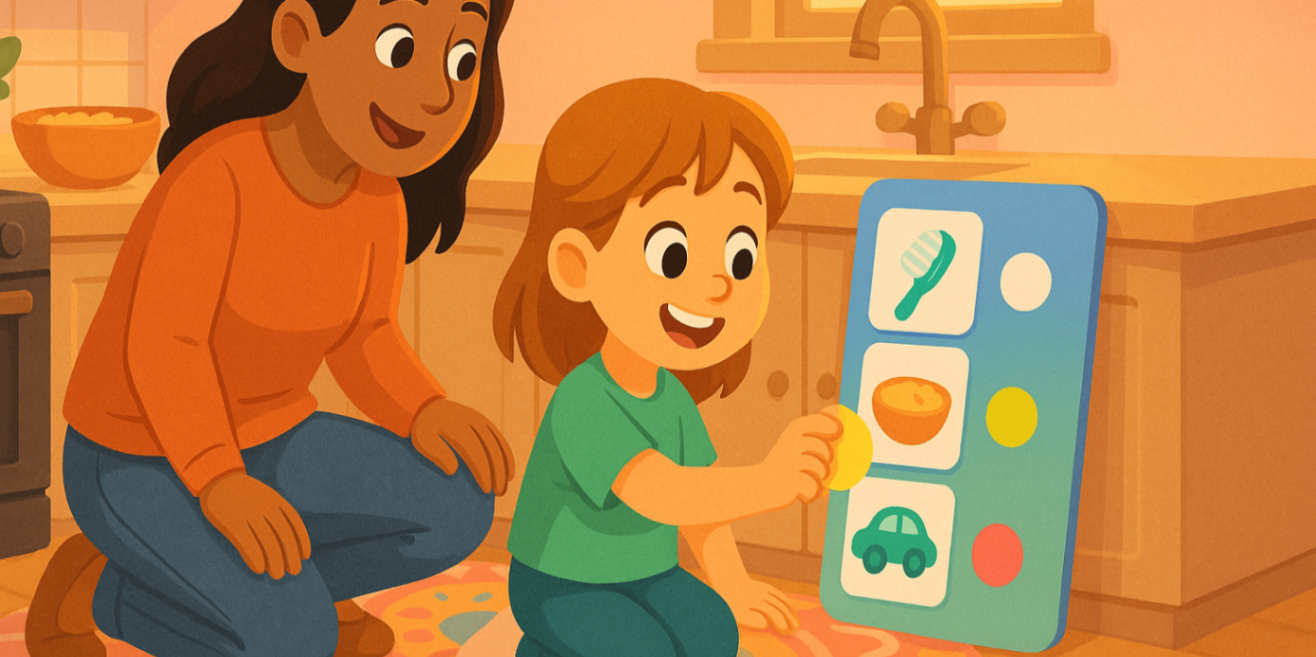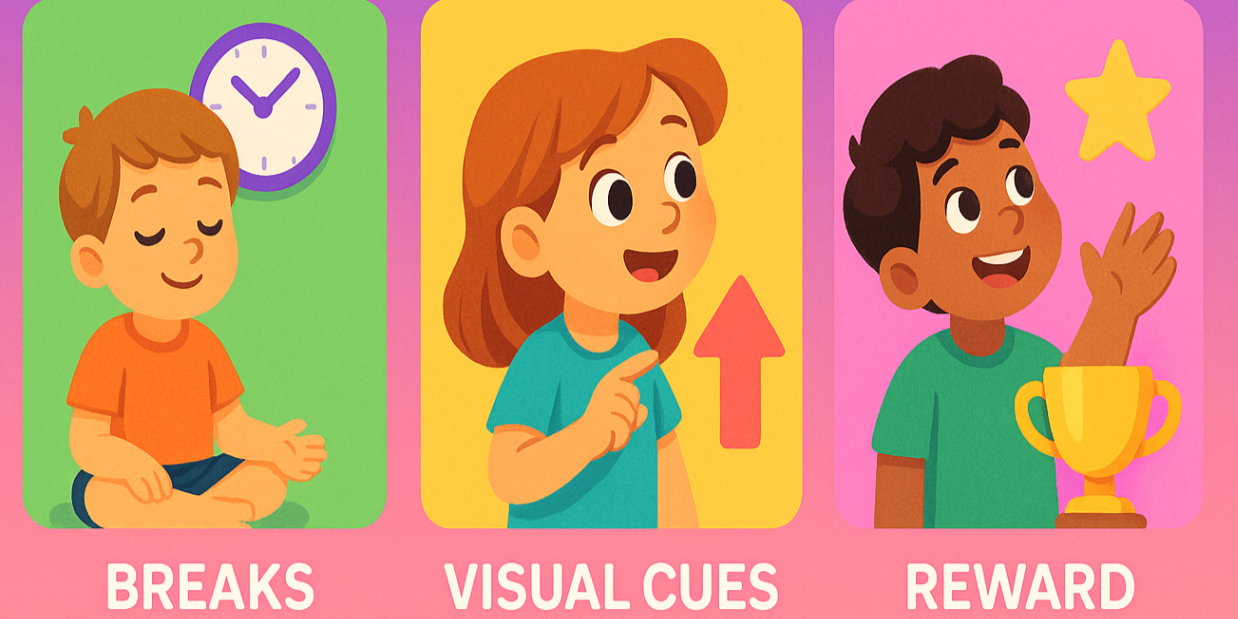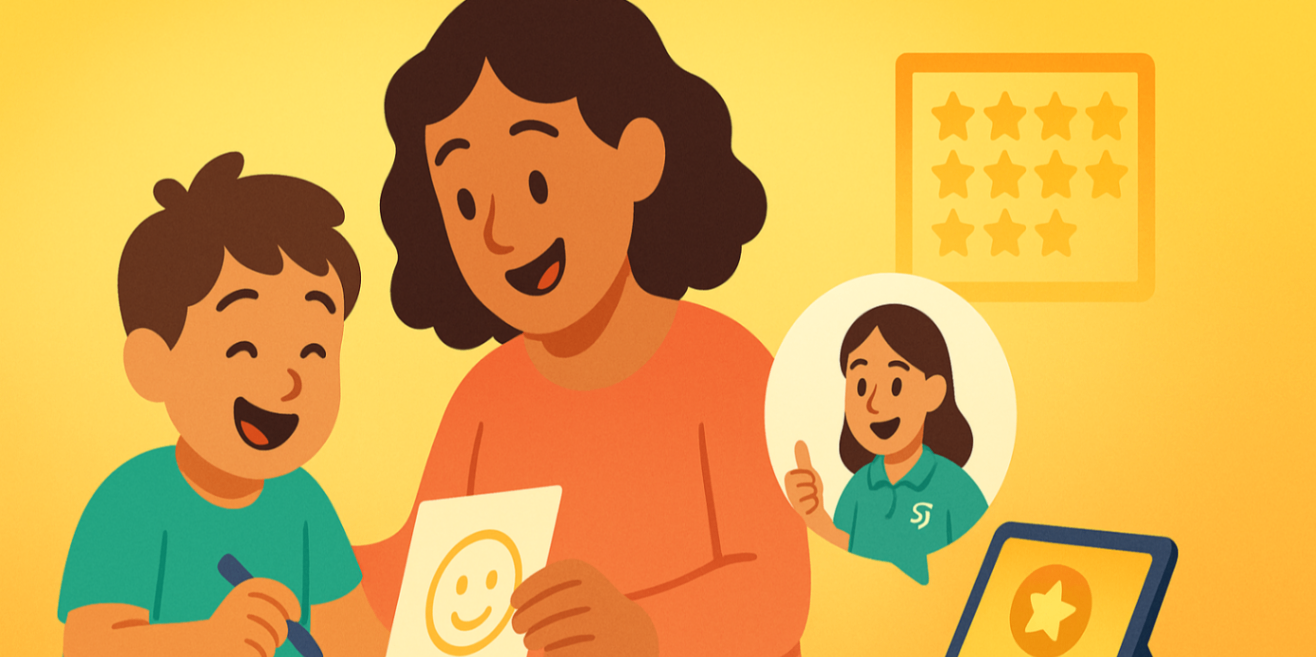
home strategies for effective behaviour therapy for kids
26 August, 2025
Introduction
If your child is having a hard time because of feelings or how they act, you might have heard that behaviour therapy can help. This type of help is known to work well. It looks straight at dealing with or cutting down on tough actions. Unlike other ways of getting help, behavioural therapy does not spend a lot of time talking about what happened in the past. It uses easy, step-by-step methods to help things get better.
Key Highlights
-
Behaviour therapy provides practical strategies to help manage your child's challenging actions and improve their well-being.
-
Recognising early signs, like frequent tantrums or social difficulties, is the first step toward addressing problem behaviours.
-
Parent involvement is crucial; techniques like a positive parenting program and consistent reinforcement can be used at home.
-
This guide offers a five-step process to teach new skills and reduce unwanted behaviours, boosting your children’s mental health.
-
Behavioural therapy is an evidence-based approach that focuses on understanding the reasons behind behaviours to create lasting change.
-
Early and strategic intervention can lead to significant long-term benefits for your child and the entire family.
Recognising When Your Child May Benefit from Behaviour Therapy
 It can be hard to tell when your child's actions are a normal part of growing up or when they point to something deeper. Kids may show defiance from time to time, but long-lasting behavioural problems can make family life tough and can hurt your child’s mental health. Do you see patterns at home or school that cause stress?
It can be hard to tell when your child's actions are a normal part of growing up or when they point to something deeper. Kids may show defiance from time to time, but long-lasting behavioural problems can make family life tough and can hurt your child’s mental health. Do you see patterns at home or school that cause stress?
It is key to spot early signs that your child may need help. Picking up on problem behaviours early keeps them from getting worse. This helps you step in at the right time, which can make life better for your child and your family. The next parts will talk about what signs to look for.
Want a plain-language introduction to PBS principles and how they help families? See Understanding Specialised Positive Behaviour Support for Kids.
Common Signs and Red Flags in Childhood Behaviour
Some things your child does may show that he or she needs help with children’s mental health. These signs are more than normal childhood stages. They might get in the way of everyday life, trouble the whole family, or slow down how your child gets along with other people. Noticing these issues right away is the first step to give help.
What are the main signs? Sometimes, your child might have strong emotional outbursts that do not match what is going on. This kind of disruptive behaviour is tough for the whole family. You might also see your child refusing to follow rules or always saying no, and this could point to a deeper problem.
Some other negative behaviours you can watch for:
-
struggles with other kids, like not making or keeping friends.
-
trouble telling you what they need or how they feel, which can lead to frustration.
-
strong reactions to small things going wrong or when there is a change in routine.
When these actions keep happening and your child does not seem to get better, it can be good to reach out for advice from someone who knows mental health. The first step to helping your child is to act now.
Differences Between Typical and Concerning Behaviours
Distinguishing between typical behaviour and concerning behaviours is a common challenge for parents. All children test boundaries, but the frequency, intensity, and duration of the behavior are what matter. For instance, a toddler having a tantrum is normal; a school-aged child having daily, intense meltdowns may be a cause for concern.
Behaviour therapy is highly effective for a wide range of general child behaviour problems. Through behaviour analysis, a therapist can help identify the triggers and functions of a specific behaviour. This process helps you understand why your child is acting a certain way, allowing for targeted strategies that teach positive alternatives instead of just punishing the negative action.
Here is a simple breakdown of typical versus concerning behaviours:
|
Typical Behaviour |
Concerning Behaviours |
|---|---|
|
Occasional defiance or talking back. |
Persistent opposition and hostility toward authority figures. |
|
Shyness in new social situations. |
Complete withdrawal or inability to make or keep friends. |
|
Feeling upset after a disappointment. |
Extreme emotional reactions to minor setbacks and difficulty calming down. |
|
Having a tantrum when tired or hungry. |
Frequent, intense tantrums that are disruptive and hard to manage. |
5 simple things parents can do today: Behaviour therapy for Kids
 You do not need to wait until a therapy session to help your child right away. You can use many ideas from behaviour therapy at home. With things like behavioural parent training, you can get skills that help you handle tough behaviours and build a better relationship with your child.
You do not need to wait until a therapy session to help your child right away. You can use many ideas from behaviour therapy at home. With things like behavioural parent training, you can get skills that help you handle tough behaviours and build a better relationship with your child.
The main goal is to use positive reinforcement. This helps your child do good things more often. You also set clear and steady limits. These steps are not just about discipline. They help your child learn better ways to talk and handle their feelings. The parts that come next give easy steps for you to start using these tools in your everyday life.
How to use this guide (short how-to)
This guide shows you five simple steps for using strong behavioural therapy techniques right away. It is here to help you teach your child good skills and to cut down on hard-to-handle behaviours. All of the tips are based on trusted parent training programs.
The tips in this guide work for young children and older kids. If your child is younger, you might want to use pictures or clear rewards. With teens, you can shift focus to help with problem-solving and talking things out. The main ideas of behavioural therapy and parent training stay the same no matter your child’s age.
To get the most from this guide, follow the steps below:
-
Start with one clear behaviour that you want to change.
-
Break the skill into easy and small steps your child can do.
-
Give positive reinforcement each time your child does well.
-
Use visual cues so your child knows what is expected.
-
Practice many times and help your child use the skill in real-life situations.
Remember, these behavioural therapy techniques are here to help you, so you and your child can get the best results with these steps.
Step-by-step How To: 5 practical routines to teach positive skills
Building a setup that helps kids show good behaviour can make a big difference in the way they grow. Make a steady daily plan for, everyday jobs. This helps them know what will happen next and, this supports their, emotional regulation. Use play therapy, ideas to help them learn social skills. It is good to use, positive reinforcement, by praising when they show good behaviour.
Get the family members, involved in parent training. This helps everyone have the same plan and, it builds better communication skills. Have some quiet time set aside for, mindfulness, activities often. These help children deal with, distress and support their, mental health.
Step 1 — Define one clear, measurable goal (SMART)
The first step in good behavioural therapy is to pick a single, clear goal. If you try to change many things at one time, it can be too much for you and your child. It is better to focus on one simple goal that you can measure. This way, your energy goes to what will matter the most.
One way to do this is to use a SMART goal. This means the goal should be Specific, Measurable, Achievable, Relevant, and Time-bound. For example, instead of saying, "I want my child to be more responsible," you can say, "I want my child to put their toys in the bin every evening before bed for five days in a row." This makes it very clear what you want your child to do. It’s an important part of behaviour analysis.
When you have a goal that is easy to understand, you can track how things move ahead. This lets you see little wins and talk about them as you move along. There is no confusion for your child. They know what you want. By being clear, you help set your child up to do well. This way of working is used in many types of therapy, like Applied Behaviour Analysis (ABA), and is part of behavioural therapy.
For examples of FBA-led planning and tailored strategies that translate into everyday routines, read Specialised Behaviour Support: How NDIS Plans Create Tailored Strategies for Children.
Step 2 — Break the skill into tiny steps (task analysis)
Once you have a clear goal, the next thing to do is break the big skill down into smaller, easy steps. This is called task analysis. It is really useful when you are teaching new skills or working on things that have many parts. Kids can have a hard time with big tasks like getting ready for school. It can make them feel stressed or like it is just too much.
If you break it into little steps, it is much easier. You can make a simple checklist. For example, to get ready for school: 1) get out of bed, 2) use the toilet, 3) get dressed, 4) eat breakfast, and 5) brush teeth. Your child can do each one, and each time they finish a task, they get a small win. Behaviour analysis uses this way a lot to help teach all kinds of things, from new skills to basic motor skills.
You can use a picture chart to help make this even more fun. When your child does a step, they can put a sticker or a check next to it. This helps turn a normal routine into a fun game. It helps your child build confidence and see that they can do it. By doing this, you help keep them moving forward without feeling lost.
Step 3 — Use consistent, immediate reinforcement
One of the most helpful tools in behavioural therapy is positive reinforcement. In this approach, you reward your child right after they do the action you want to see. The reward does not have to be big. You can use verbal praise, give a high-five, put on a sticker, or let them have a few more minutes to play. The most important thing is that the reward is given every time and right after the behaviour.
This method works well for children with ADHD. It gives them quick feedback and motivation, so they can stay focused. For example, if you want your child to sit at the table to do homework for 10 minutes, you should thank them or give a small reward as soon as the time is up. This helps your child link good behaviour with a good result.
Giving these rewards all the time also helps your child grow their communication skills. It shows them clearly what you expect, and it also tells them that their hard work is seen and matters. This positive moment together will build a strong bond between you and your child. It will also help them want to do the good behaviour again.
Step 4 — Add visual supports and clear cues
Verbal instructions can be hard for kids, especially if they are young or feel stressed. Using visual supports helps to make things clear and lower stress for both you and your child. You can use tools like picture schedules, checklists, or timers. These help your child see what they need to do and when.
For example, a visual schedule for the morning can help guide your child from one step to the next. You will not need to keep giving reminders. This can help your child's behaviour and helps them learn to do things on their own. Visuals are a way of talking without words that help your child understand better. This is important when you want to build their communication skills.
Giving a clear cue is helpful, too. You might point to the right picture or say, "Check your chart." Simple cues like these can remind your child what comes next. These supports help make a routine that your child can count on. It lets them know what you want from them, and this helps your child feel more safe and in control.
Step 5 — Practice in short, frequent sessions & generalise
Mastering a new skill means you have to keep practicing. It is better to do short and regular practice during the day, not long and tiring sessions. If you want to learn polite greetings, you could practice for one or two minutes each time someone walks into the room. This way, learning feels more relaxed. It does not feel like a strict lesson.
One of the main goals of behavioural therapy techniques is generalisation. That means using the new skill in many different places. If your child learns a new behaviour at home, help them try it at the park, in a store, or at a family member’s house. This way, now the skill feels more natural in their day.
Every child is different, so you may not see change quickly. The biggest thing is to keep practicing often and focus on generalisation. That will help your child learn faster and turn their new behaviour into a habit. The progress may be slow at first. Be sure to celebrate every small success you see.
Addressing Specific Behaviour Challenges at Home
 The strategies shared above can be changed to fit the different problem behaviours that many families deal with. Things like tantrums, not listening, and trouble with emotional regulation often make life hard for all family members. Behaviour therapy gives you steps to manage these problems in a helpful way.
The strategies shared above can be changed to fit the different problem behaviours that many families deal with. Things like tantrums, not listening, and trouble with emotional regulation often make life hard for all family members. Behaviour therapy gives you steps to manage these problems in a helpful way.
If you know what starts these behaviours and keep using the same clear steps, you will help your child learn better ways to cope. In the next sections, you will see simple tips for handling two big problems: tantrums and emotional regulation issues. These ideas let you act in a good way and help your child grow.
Managing Tantrums and Defiance
Frequent tantrums and negative behaviours can be hard for parents to deal with. These times of disruptive behaviour often come up when a child feels too much and does not know how to say what they need in a better way. The main thing is to be calm and always respond the same way.
Do not try to fight for control. Instead, let your child know you see their feeling but keep your rule clear. You can say, "I know you're upset we have to leave the park, but it's time for dinner." If you stay calm, you show your child how to handle their own feelings. Another good thing is to make coping skills fun, such as "lion breaths" to let out their anger.
Here are some ways to deal with negative behaviours like tantrums and defiance:
-
Set clear and simple rules. Always follow them.
-
Praise your child when they handle anger or follow directions well.
-
Use redirection to move their attention from what is wrong to a better thing to do.
-
Make a "calm-down corner" with soft things where they can go to work on emotional regulation.
Supporting Emotional Self-Regulation
Helping your child learn emotional regulation is key to their mental health and happiness. If children have a hard time with their feelings, even small things can lead to big distress. It’s your job to show them how to know what they feel and how to react in healthy ways.
Begin by building their emotional vocabulary. Name their feelings out loud. You can say, "It looks like you are feeling angry because your tower fell." Saying this lets your child know that you see and understand their emotions. It also helps with their communication skills. Once they can say what they feel, you can teach them what to do when those feelings show up.
Here are some ways you can help your child with emotional regulation:
-
Teach deep breathing. This helps them calm down.
-
Make a feelings chart. This is so they can spot and talk about how they feel.
-
Show healthy emotional habits yourself.
-
Talk about any problems after there is time to calm down. This helps you both work out a better answer for the future.
Remember, working on these things with your child can help their mental health now, and as they get older. It gives them good communication skills for life.
Parent Involvement in Behaviour Therapy
Parent involvement is not something extra in behaviour therapy. It is very important. Therapies like Parent-Child Interaction Therapy (PCIT) and Parent Management Training (PMT) work because caregivers lead the way in making things better. The skills you learn in therapy need to be used and practiced at home, and the things you do will help your child even more.
Most of the time, this means being a part of parent training. In these sessions, a therapist will help you with tips on how to handle and answer to different behaviours. Sometimes, the whole family might join family therapy. This helps everyone talk better, solve problems, and feel more connected. You will get to use your authority in a kind and steady way, which helps make your home a better and calmer place for everyone.
Setting Consistent Boundaries and Expectations
Setting clear and consistent boundaries is important in any positive parenting program. When you change rules often, your child might be confused and will try to push limits. Keeping rules the same helps your child know what to expect. This way, they can feel safe.
If you are a caregiver, it is your job to make clear rules and follow through with what happens next, both good and bad. For instance, if you have a rule like "no screen time before homework," you should keep that rule every day. The goal is not to be too strict, but instead to give your child the right help to grow well.
If you find it hard to set boundaries, a behaviour therapist can help. You may ask your child's pediatrician for help finding one. Websites like the American Psychological Association can also help you find therapists nearby. A therapist can show you steps that work best for your family's needs.
If you’re ready to turn practical strategies into a measurable plan with parent coaching and school collaboration, read Preparing for Your First Behaviour Support Appointment: A Parent’s Checklist.
Conclusion
To sum up, behaviour therapy gives parents easy ways to help their kids learn good skills and handle tough times better. If you notice signs that show your child might need the therapy, being part of the process helps create a space where they can grow and learn to deal with their feelings. Setting clear goals, using rewards often, and trying visual supports are simple steps that can help change your child's behaviour in a real way. It takes patience and sticking with it, since change can take time.
Frequently Asked Questions
How long does it take to see results from behaviour therapy for kids?
How long it takes to see results from behavioral therapy can be different for every child and family. The progress depends a lot on how often you use the strategies at home. Some people may notice small changes in a few weeks. But real, lasting change happens slowly with time and regular practice.
What can parents expect in a first behaviour therapy session?
The first step in behavioural therapy is an evaluation. A therapist will talk with you and your child. The therapist wants to know the challenges you are facing. They will ask about your family's history and help set clear goals for treatment. This first meeting is focused on making a plan that fits your family best.
.svg)












